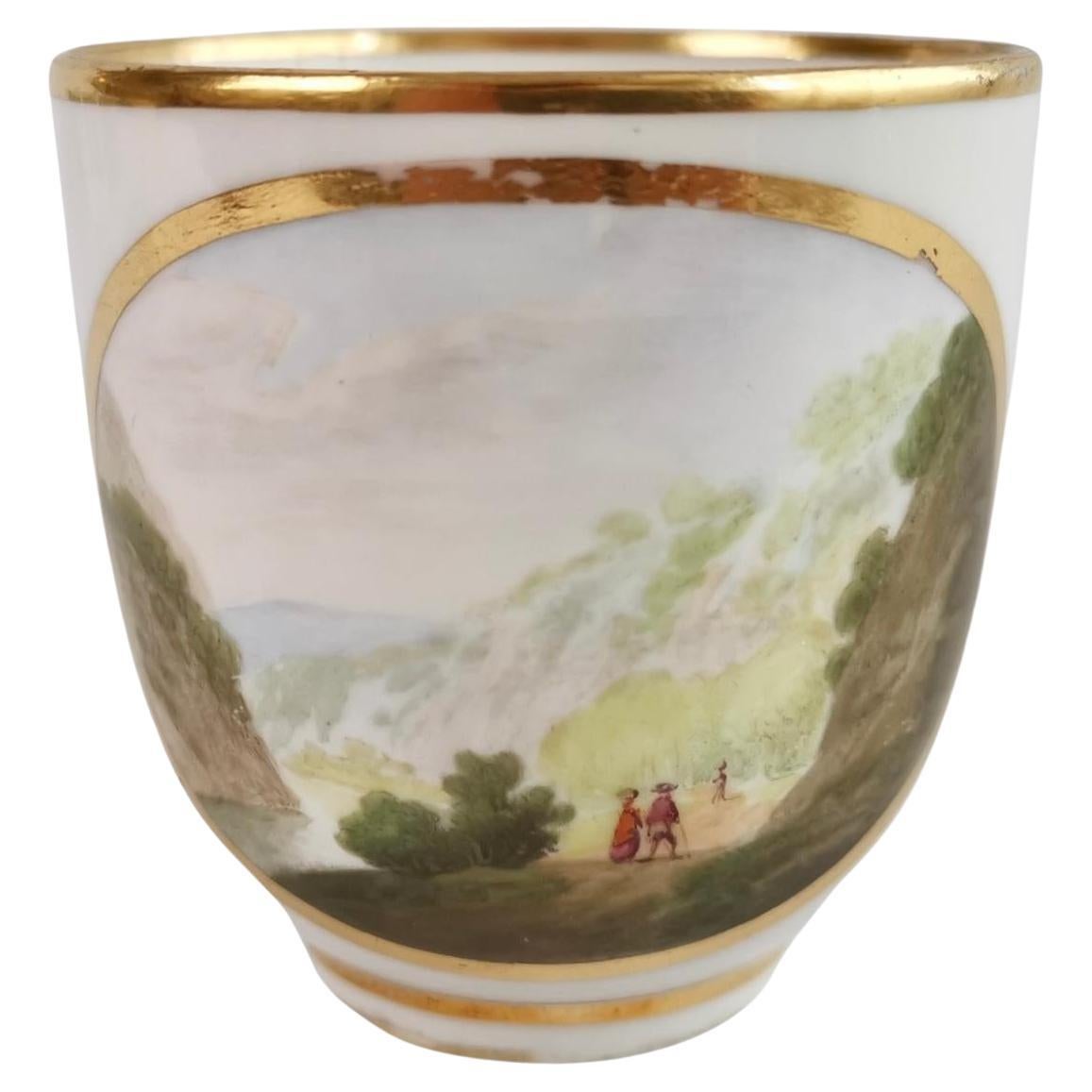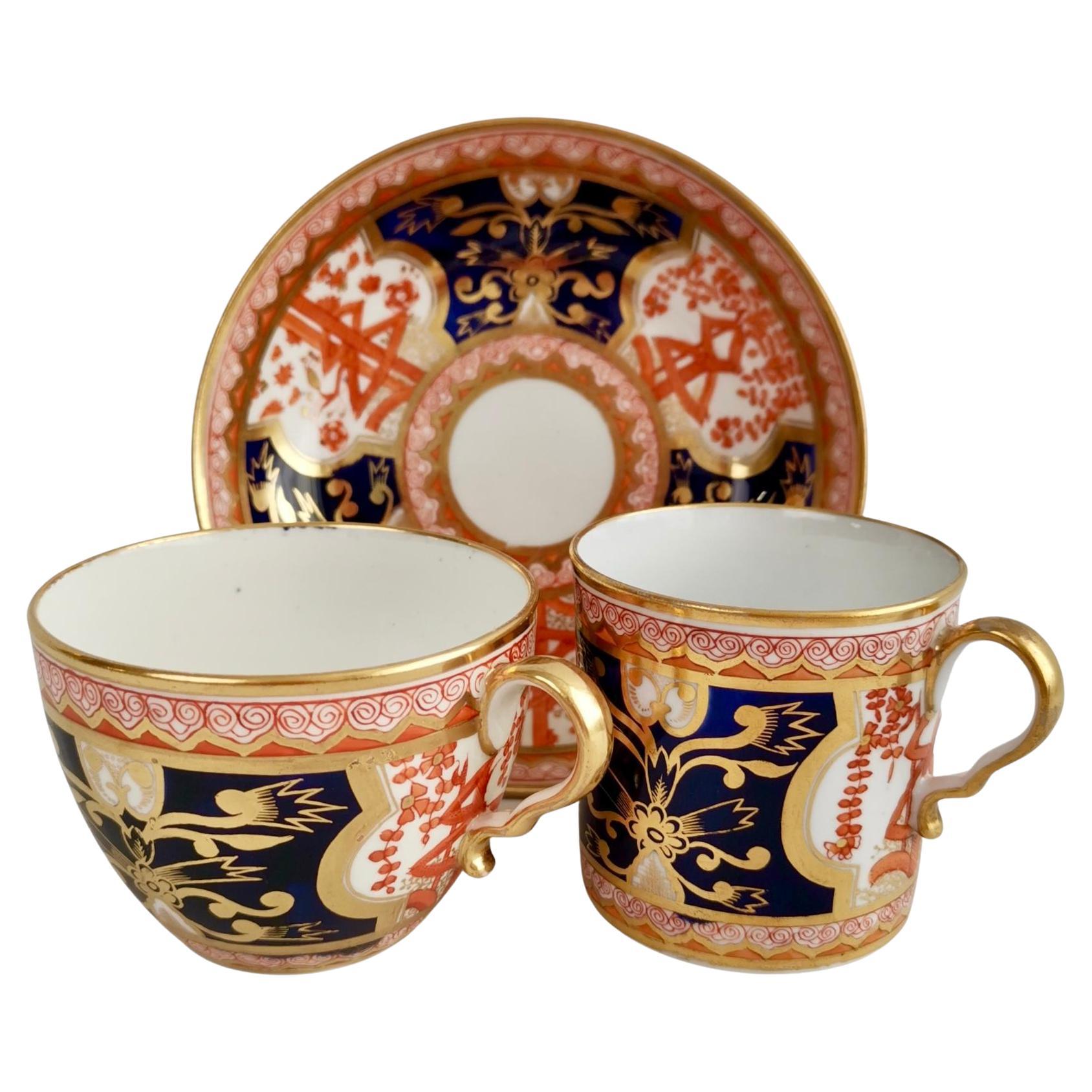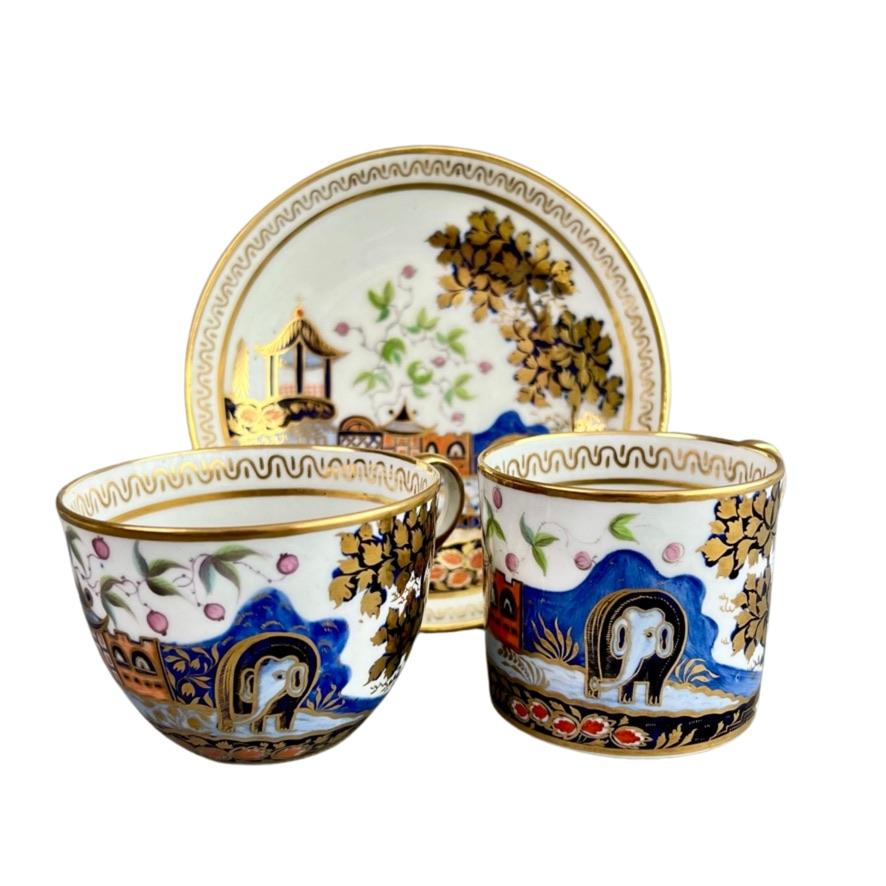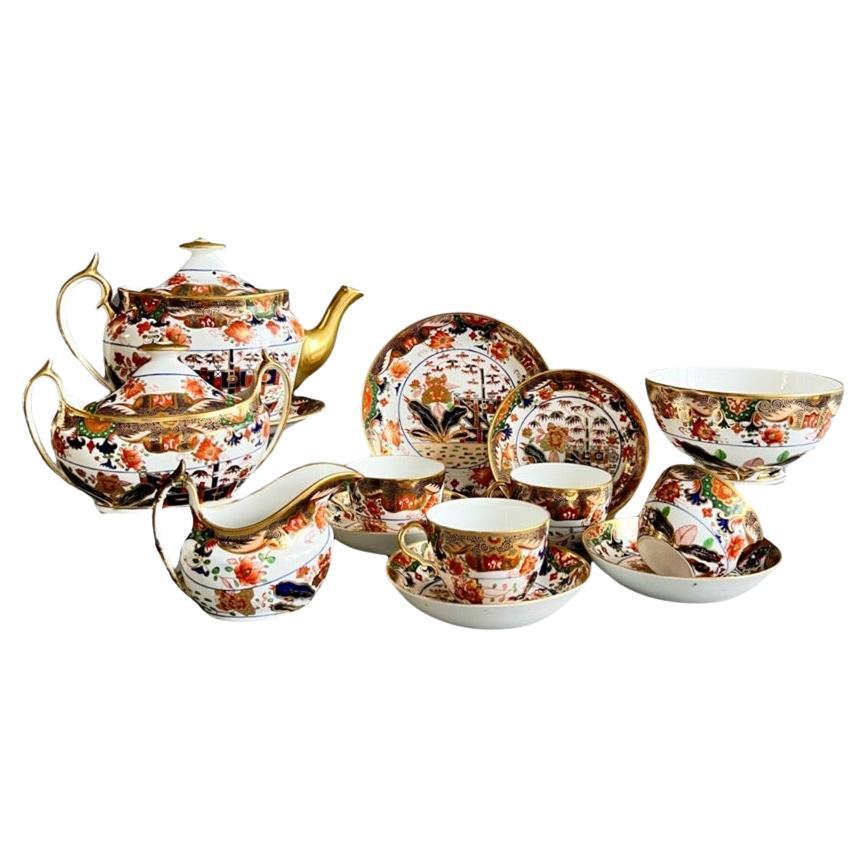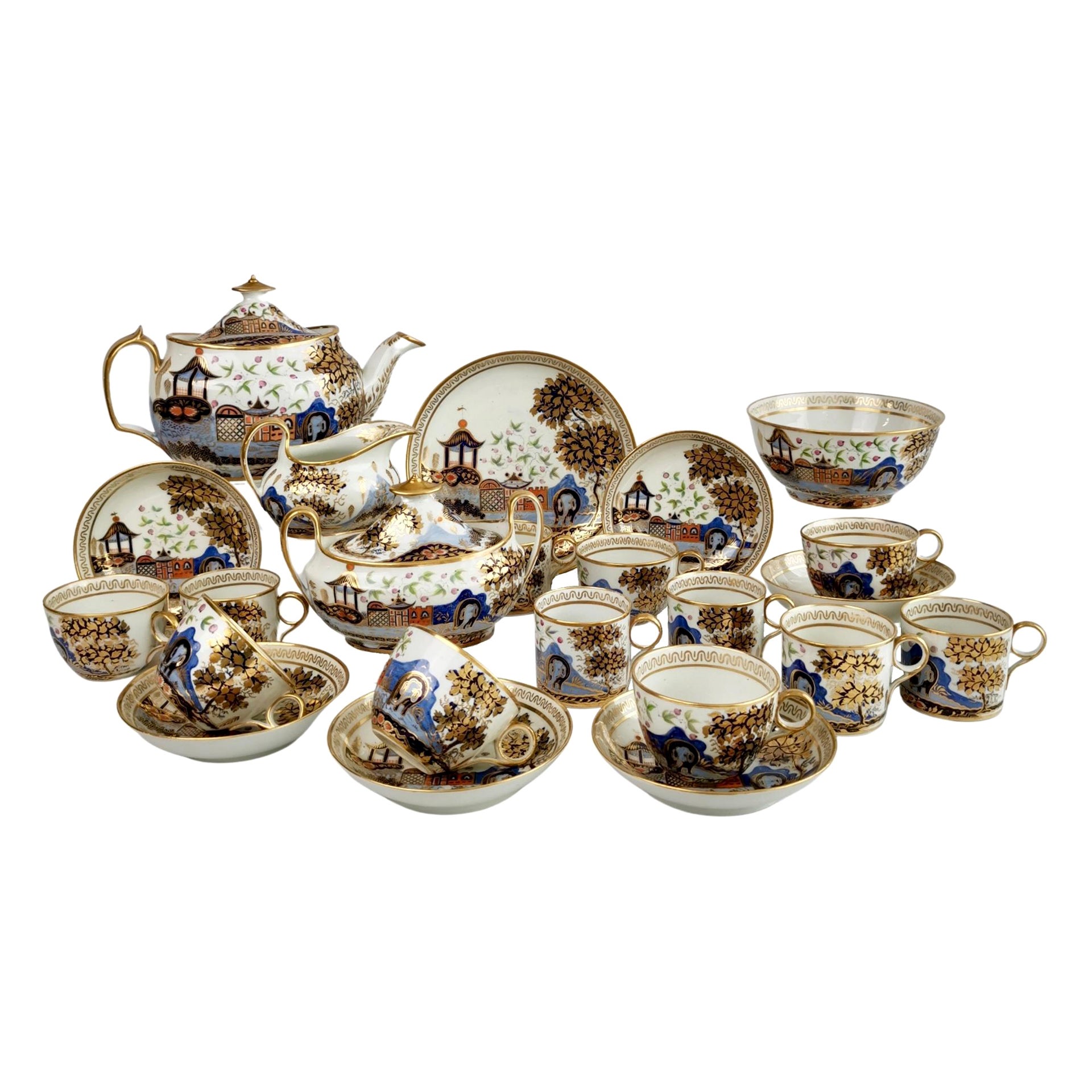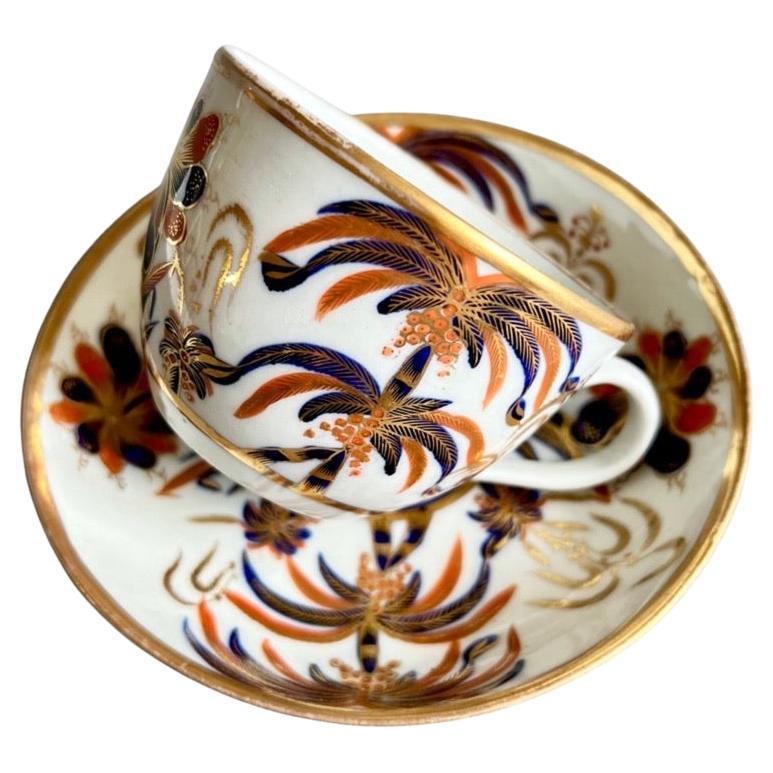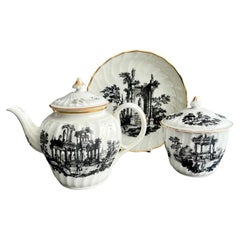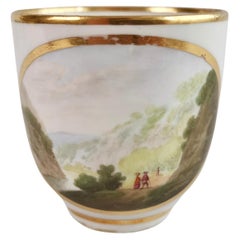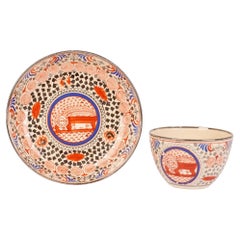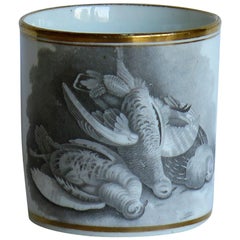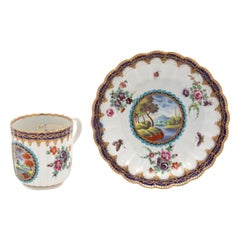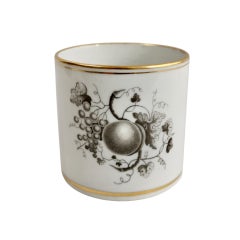
Thomas Wolfe Factory Z Coffee Can, Bat Printed Monochrome Fruits, ca 1810
View Similar Items
Thomas Wolfe Factory Z Coffee Can, Bat Printed Monochrome Fruits, ca 1810
About the Item
- Creator:Staffordshire (Manufacturer)
- Dimensions:Height: 2.4 in (6.1 cm)Diameter: 2.5 in (6.35 cm)
- Style:Regency (Of the Period)
- Materials and Techniques:
- Place of Origin:
- Period:
- Date of Manufacture:1810
- Condition:Wear consistent with age and use. In perfect antique condition without any damage, crazing or repairs, and only very minimal wear.
- Seller Location:London, GB
- Reference Number:Seller: A-WOL021stDibs: LU4805124517572
Staffordshire
Thanks to its reserves of clay, lead, salt and coal, Staffordshire, England, has been a center for ceramics since the early 17th century. The county was home at one time to hundreds of pottery workshops and as many as 4,000 bottle-shaped kilns that operated year-round. The term “Staffordshire Potteries” refers to the industrial area of Stoke-on-Trent — comprising the towns Burslem, Fenton, Hanley, Longton, Stoke and Tunstall — where most of the production was concentrated.
In 1720, potter John Astbury discovered that he could make what would later be called creamware by adding ground flint powder to the local red clay. Because resources were so plentiful in Staffordshire, local potters could afford to experiment, working to refine their techniques and designs. One such innovator was Thomas Whieldon, an important 18th-century potter known today for his tortoiseshell ware, whose brilliant glazed surface of caramel, yellow and green hues was made with copper and manganese compounds. Whieldon operated the Fenton Low workshop, making coffee- and teapots, dinner services and even ornamental knife hafts. He was an influential figure: Josiah Spode apprenticed at the workshop, and Josiah Wedgwood partnered with Whieldon for five years before establishing his eponymous firm in 1759.
Wedgwood is perhaps the best known of the Staffordshire potters. The firm produced a line of light-colored earthenware for Queen Charlotte, who liked it so much that she granted permission to market it under the moniker Queen’s Ware, which despite the name, was designed for everyday use. In the same regal vein, in 1773, Wedgwood created the 954-piece Frog service for Catherine the Great, of Russia. The company is also known for its black stoneware, Black Basalt, which imitates the color and shapes of Etruscan vases; Jasperware, with its classical reliefs applied on the unglazed body; and pearlware.
By the end of the 18th century, Staffordshire was the primary producer of ceramics for the American colonies, even creating patriotic wares celebrating independence for this market. The imagery on Staffordshire ceramics became more standardized the mid-18th century with the advent of transferware, in which a design etched on a copper plate is printed on tissue paper, which is then used to transfer the wet ink onto the ceramic surface. This technique enabled artisans to decorate their wares with complex scenes that wrapped around an object’s surface and make several copies of popular patterns.
The Staffordshire potters also produced decorative figurines, such as this charming pair of cows dating from the 19th century. Particularly popular in Great Britain were pieces with hunting imagery, such as this George IV porcelain stirrup cup in the shape of a fox head wearing a gilt collar inscribed with the word “Tallyho.” Among the many whimsical vessels produced is this mid-19th-century frog mug. The exterior is painted with a charming scene of people picking fruit on one side and ladies on a garden swing on the other side, while inside a molded frog’s head at the bottom of the mug makes a gurgling sound when the the beverage has been almost completely consumed.
- Worcester Coffee Cup, Monochrome Black Print "Tea Party no.3", Georgian ca 1760By 1st Period Worcester Dr. WallLocated in London, GBThis is a very charming coffee cup and saucer made by Worcester in their First Period (sometimes called the Dr Wall Period) in about 1760. The items are decorated in a black overglaz...Category
Antique 1760s English George III Porcelain
MaterialsPorcelain
$590 / setFree Shipping - Flight Worcester Teapot Set, Monochrome Print "Ruins" Pattern, Georgian ca 1790By Flight WorcesterLocated in London, GBThis is a beautiful set of a teapot, a sucrier with cover, and a plate made by Worcester in its Flight period, around 1790. You can tell from the generous size of the teapot that it ...Category
Antique 1790s English George III Porcelain
MaterialsPorcelain
$1,595 / setFree Shipping - Derby Orphaned Coffee Can, White, Landscape by Zachariah Boreman, ca 1790By DerbyLocated in London, GBThis is a very rare and stunning little orphaned coffeecup made by Derby in about 1790. The cup has a white ground, simple gilt rims and a stunning named mountain landscape painted by Zachariah Boreman. The Derby factory, later reshaped into Royal Crown Derby, is currently the oldest British porcelain factory still in production. Derby was one of the most prominent potteries right from the start of English porcelain production in the mid 1700s to today. Their items are of exceptionally high quality and many of the designs have become iconic, particularly the Imari designs; many of these are still being made today. Derby made many exciting designs in the Regency era, and this cup, which would have belonged to a large tea service, is a beautiful example. The marking at the underside indicates that the cup was produced some time between 1782 and 1800, however the style is from the mid-1790s. Zachariah Boreman was one of the most celebrated painters at Derby. He arrived at Derby around 1774 after working at Chelsea, and remained until 1794, when he left in frustration with Michale Kean, the owner. Even though Boreman became one of the prime landscape painters at Derby, Kean would not pay him more and this caused Boreman to go back to London and work for the Simms decorating studio. Boreman was most probably influenced by Paul Sandby, the chief drawing...Category
Antique 1790s English Georgian Tea Sets
MaterialsPorcelain
- Spode Porcelain Teacup, Imari Tobacco Leaf Pattern 967, Regency ca 1810By SpodeLocated in London, GBThis is a beautiful teacup and saucer made by Spode in about 1810. The set is decorated with the famous Imari Tobacco Leaf pattern 967, which was first introduced by Spode in 1806. ...Category
Antique 1810s English Regency Porcelain
MaterialsPorcelain
- Spode Porcelain Teacup Trio, Red Imari Dollar Pattern, Regency, ca 1810By SpodeLocated in London, GBThis is a beautiful orphaned teacup made by Spode in about 1810. It bears a beautiful Japanese-inspired Imari pattern. Spode was the great pioneer among the Georgian potters in England. Around the year 1800 he perfected the bone china recipe that has been used by British potters ever since, and he was also the leading potter behind the technique of transferware, making it possible for English potters to replace the Chinese export china, which had come to an end around that time, with their own designs. This was fundamental to a thriving industry that would last for about 150 years and provide half the world with their tableware. Spode porcelain is regarded as one of the highest quality porcelains around; for a soft-paste porcelain it is surprisingly hard and fine, and has a wonderful bright white colour. The pattern on this can is called "Dollar" pattern, a very famous pattern that was used by English potters in the 18th and early 19th Century. It is obvious why it is called “dollar” - but its origin is less obvious! It is thought that this pattern was derived from a very old Chinese pattern depicting a tree with elaborate foliage that hides a Chinese character representing longevity or happiness. Traditionally, this went with a an image called “Taotie”, which was used on very ancient bronze vases...Category
Antique Early 1800s English Regency Porcelain
MaterialsPorcelain
- New Hall Hybrid Hard Paste Teacup Trio, Elephant Pattern, Regency ca 1810By New HallLocated in London, GBThis is a beautiful true trio made by New Hall around the year 1810. The set is decorated in the very desired but rare Elephant pattern. A true trio is how cups and saucers were sol...Category
Antique 1810s English Regency Tea Sets
MaterialsPorcelain
- Thomas Wolfe Factory Z Lion Pattern English Teacup and SaucerLocated in Bishop's Stortford, HertfordshireA scarce antique English Staffordshire bone china teacup and saucer hand decorated with a red lion by Thomas Wolfe (Factory Z) and dating from around 1810...Category
Antique 1810s English George III Tea Sets
MaterialsPorcelain
- Georgian Spode Porcelain Coffee Can Bat Printed Game Birds Pattern, circa 1810By SpodeLocated in Lincoln, LincolnshireThis is a very good example of an English George III period, porcelain, coffee can, made by Spode, England in the early 19th century, circa 1810. The can is nominally straight sided and has the Spode loop handle with a pronounced kick or kink to the lower part, with a lower attachment that curves out slightly from the cup. Spode is the only factory with a handle of this exact shape. The can is decorated with one of their grey "bat printed" designs, showing game birds collected after the shoot. It also has hand painted gilded detail to both rims and the handle. Similar Spode bat printed...Category
Antique Early 19th Century English Georgian Ceramics
MaterialsPorcelain
- 18th Century First Period Worcester Porcelain Coffee Can and SaucerBy 1st Period Worcester Dr. WallLocated in Downingtown, PAFirst Period Worcester porcelain coffee can and saucer, circa 1772-1775 The fluted Worcester porcelain coffee can and saucer are finely painted with a central reserve with a land...Category
Antique 1770s Georgian Porcelain
MaterialsPorcelain
- Early Derby Porcelain Coffee Can att. to George Robertson, circa 1795By Derby, George RobertsonLocated in Fort Lauderdale, FLA green-ground porcelain coffee can made by the Derby Porcelain Factory circa 1795. This green-ground coffee can is a fine example of early Derby porcelain...Category
Antique 1790s English Georgian Porcelain
MaterialsPorcelain
$2,400 Sale Price25% Off - Georgian Derby Coffee Can Hand Painted & fully marked, ca. 1810By Royal Crown Derby PorcelainLocated in Lincoln, LincolnshireThis is a beautiful porcelain Coffee Can by the Derby factory, made during the late Georgian period of the early years of the 19th Century The cylindrical can tapers slightly to the...Category
Antique Early 19th Century British George III Porcelain
MaterialsPorcelain
- Early 19th Century Spode Porcelain Coffee Can Hand Gilded Pattern 1099, Ca 1810By SpodeLocated in Lincoln, LincolnshireThis is a fine example of an English George III period, porcelain, coffee can (cup), made by Spode in the early 19th century, circa 1810. The can is nominally straight sided and h...Category
Antique Early 19th Century English Regency Ceramics
MaterialsPorcelain



